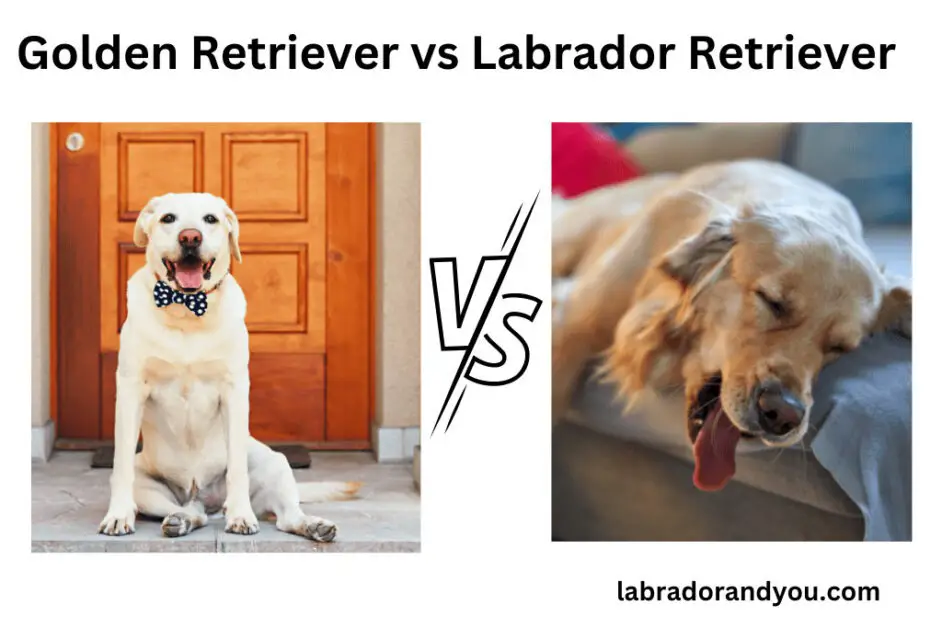Labrador Retrievers are among the most popular dog breed choices for their friendly nature and loyalty. Choosing between a chocolate lab vs black lab can be tough. Both share many similarities but have distinct differences in appearance and temperament. Black Labs are characterized by their black fur, while chocolate Labs exhibit fur that ranges from mahogany to deep, dark brown.
A small white patch on the chest is acceptable in either color. Black Labs have black noses, eye rims, and mid to dark brown eyes, while chocolate Labs feature brown noses, eye rims, and light brown or hazel eyes. They both have webbed toes and an otter-like tail, making them excellent swimmers. They even have a waterproof coat!
Chocolate Lab vs Black Lab – Understanding the Difference
While black Labs are a more common sight, chocolate labradors have become common over the years. The coat color comes down to genetics. The following will help you understand the difference: The color of a Labrador’s coat is determined by two ‘bee’ genes, one from each parent. Two types of ‘bee’ genes: big B (dominant) and little b (recessive).
A black labrador retriever has two big B genes (BB) or a big B and a little b (Bb). Chocolate labrador retriever has two little b genes (bb). If both parents are black but carry a recessive little b chocolate gene, they can still produce chocolate puppies.

History of Chocolate Lab and Black Lab Breeds
You can trace the evidence of the origin of the Labrador Retriever back to Newfoundland in Canada. The name “Labrador” is derived from the Portuguese term “lavrador,” which means small landholder.
A Portuguese explorer who settled in Newfoundland in the 16th century is behind this name. A few water-retrieving dogs were transported across the ocean to Europe, bred into distinct breeds for specific tasks. The Labrador’s forebears are shrouded in mystery. However, fishermen frequently used dogs to retrieve fish that had fallen off hooks.
English settlers in St. John’s, Newfoundland, introduced working dogs from Poole Harbor, Dorset to England. No written records trace the St. John’s dogs’ origin and lineage. Hence, their ancestors can only be speculated.
Some antecedents include the black St. Hubert’s hound from France, Portuguese water dogs, old European pointer breeds, and native dogs. Before 1889, all Labradors were either black or black with white markings. In 1892, Buccleuch’s kennel witnessed the birth of the earliest recorded Labradors in a liver or chocolate color.
The origins and the hot spots of these Labradors remain unknown. There is speculation that they resulted from breeding with a German Pointer. These early Labradors paved the way for the breed’s future development. Their unique coloring is considered fascinating by many Labrador enthusiasts.
Fun Facts about Chocolate Labs and Black Labs
Labradors can come in 6 different coat colors – black, yellow, fox red, silver, white, and chocolate. Their genes determine the color of their coat. Black Labradors can have BB or Bb genes, but the dominant black gene overrides the recessive brown gene.
By mating two black Labradors, getting all three coat colors in the same litter is possible. The silver coat color in Labradors is caused by a pair of genes called “dee” genes. When two little dd genes are paired, they dilute the coat color to a striking silver.
English Labradors
The”show labs” are bred for dog shows in the show ring. These show dogs have blocky heads, thick necks, and stocky bodies. The conformation dogs have a calmer and laid-back temperament, making them ideal family pets. The English lab is also more trainable, obedient, and willing to please its owners.
American Labradors
American Labradors are bred for their working ability, particularly in hunting. These “field dogs” have a leaner build, long legs, and a narrower head than English labs.
American Labradors have a higher energy level and are more athletic. They are also more independent.
Appearance Dissection
chocolate lab size
These dogs stand between 21.5 and 24.5 inches tall at the shoulder. A chocolate pup reaches its full adult size within 6-12 months.
The breed standard weight is between 55 and 80 pounds. Males are usually larger than females. A dog’s weight can vary throughout life, depending on genetics, age, and lifestyle.
Coat
- The coats range from short to medium length.
- The chocolate Labrador’s coat can exhibit a range of shades, from a pale brown tint to a dark brown tone. It may display traces of gold or red undertones, giving it a distinct and lovely appearance.
- The undercoat is soft and water-repellent, while the outer coat is dense, thick, and straight.
- The chocolate coat color is because they receive the recessive brown gene from the same parents.
Black Labrador retriever
Size
- Black Labsgrow to a height of 21-25 inches at the withers, with females slightly smaller than males.
- By six months, most dogs have reached about 75% of their full adult height.
- As such, a 7-month-old black Lab should be roughly 15-18 inches tall.

Weight
- Adult female black Labs usually weigh between 55-70 pounds, while males weigh 65-80 pounds.
- At six months old, black labrador puppies have reached about 2/3 of their adult weight.
- A female labrador puppy should weigh 40-50 pounds, while a male puppy should weigh 45-55 pounds.
Color of Black Labs:
- Few may have a beautiful charcoal color.
- Some incur white spotting on their toes and chest.
- They tend to get some grey coloring around their muzzle with age, giving them a wise appearance.
Coat of Black Labs:
- They have a thick double coat, which is low maintenance.
- The outer short layer allows them to move easily through the water.
- Their underlayer of fur keeps them warm while they swim.
- These pups shed most of the year.
- Expect to find lots of dog hair around your home.

Temperament Comparison: chocolate and black lab
Research suggests that chocolate-coated labrador retrievers are slightly less trainable and more hyperactive than their black or yellow labs.

black vs chocolate lab: Training Differences
Chocolate Labs:
- These wonderful dogs are easy to train because they are even-tempered and intelligent.
- Positive reinforcement training, using praise, treats, and toys, provides the best results.
- Housebreaking, bite inhibition training, crate training, and basic obedience can begin at eight weeks old.
- Start with commands like “sit,” “lie down,” and “stay,” and be patient with them.
- Never resort to punishment, as it can be detrimental to their training.
- Socialization during the first 16 weeks of a puppy’s life is critical for preventing anxiety and destructive behavior in adulthood.
- Exposure to different environments is essential, just like yellow labs.
Black Labs:
- Black Labs are the easiest Labradors to train.
- They are brilliant and can learn any task taught to them, similar to a yellow lab.
- They are a common choice for service, search and rescue tasks, drug/bomb detection, and police work.
- They excel in obedience trials and agility training.
- Positive reinforcement best teaches yellow and black labs because they want to make their owners happy.
- They become bored easily, leading to destructive behavior such as chewing and digging.
- Socialization is essential for all dog breeds, and black Labradors are no exception. They are sweet and extroverted.
Are Chocolate Labs Less Trainable?
Some believe chocolate labs are less trainable than other Labrador colors. This is a myth. Like a yellow lab, it is easy to train because of its temperament and intelligence. Professionals recommend positive reinforcement training to achieve the best results.
Digging Apart Trainability Factors
Nature vs. Nurture
Like humans, dogs have a mix of nature and nurture factors that impact their behavior and trainability. While genetics determine traits like temperament and personality, a dog’s upbringing, socialization, and training are more crucial
Age
Younger puppies of a black, chocolate, fox red, or yellow lab are more impressionable and can learn faster. They have shorter attention spans and require frequent breaks. Older dogs are less energetic and playful but more experienced.
Consistency
Dogs thrive on routine and predictability. Inconsistency can lead to confusion and frustration. Therefore, using the same dog commands, rewards, and training methods consistently is essential to help the dog understand what is expected of them.
Health Comparison: chocolate vs black lab
A 2018 study indicates chocolate labs may have more health problems than black or yellow labs. Issues may be more prevalent than in black and yellow labs. However, research is still being conducted on the topic.
These two labs are vulnerable to similar health issues, such as hip and elbow dysplasia, eye problems, and obesity. Nonetheless, it’s essential to take note of some differences. Like yellow labradors, chocolate labs are susceptible to skin diseases and need regular grooming and dietary attention. Black Labs are more likely to develop ear infections. Always keep their ears dry and clean.

Exercise Needs And Requirements: chocolate and black labradors
Chocolate, yellow or black labs are lovable dogs that require much exercise to stay healthy. Activity needed varies based on age, size, and health.
General Exercise Needs
Both color Labs are high-energy dogs. Regular exercise reduces their risk of developing health problems such as obesity, joint issues, and behavioral problems.
Experts recommend that adult Chocolate Labs and Black Labs should get at least 60-90 minutes of exercise daily. However, puppies and seniors require less exercise.
Forms of Exercise
- Walking: Taking your dog on a brisk walk daily is a great way to provide them with the necessary exercise.
- Running: They are great running companions and love accompanying their owners on a jog or run.
- Swimming: Labs are natural swimmers who enjoy splashing around.
- Playing Fetch: Labs love to play fetch, which is an excellent way to keep them active.
- Agility Training: This exercise keeps your dog mentally stimulated.
Tips for Exercise
- Start slow: If your dog is not used to regular exercise, start with short walks and gradually increase the duration and intensity.
- Be consistent: Dogs thrive on routine, so exercise your dog simultaneously every day.
- Provide shade and water: Give your dog plenty of water and shade during hot weather to prevent dehydration and heatstroke.
- Check with your vet: If your dog has any underlying health issues, always check before starting any exercise routine. It will reduce the chance of exercise-induced collapse.
chocolate lab and black lab: Which One Makes a Better Pet?
These lovable and playful pups are perfect for families, but color preferences are subjective.
Coat:
Black Labs have a sleek, shiny coat that is easy to maintain. They don’t require much grooming and are less prone to shedding.
Chocolate Labs have a thicker coat that requires regular brushing to prevent matting and tangling. They also shed more, which can concern those with allergies.
Energy level:
Chocolate Labs tend to have a slightly higher energy level and may require more attention and activity. If you’re active or have a big yard for them to run around in, either color could work for you.
Trainability:
Intelligent and eager to please, both Labs can be trained easily. However, chocolate Labs are more stubborn and independent than their Black counterparts.
Size:
They are medium to large-sized dogs. Chocolate Labs may require more space as they tend to be slightly larger than Black Labs.
Personality:
Both are friendly and enjoy being around people, particularly children. Chocolate Labs are more affectionate and playful, while Black Labs can be reserved and dignified.
Who Should Get a Chocolate Brown Lab?
Here are some factors to consider before considering which color labrador to go for.
Active Families:
Chocolate Labs thrive in busy households where they can run and play with children and pets. They aren’t the right dog for you if you are inactive.
Outdoor Space:
They love to play outside, so they must have ample space to roam and play. A backyard or a nearby dog park is ideal.
Training:
They require consistent positive training to prevent destructive chewing and excessive barking. This dog isn’t for you if you can’t commit to training.
Time Commitment:
These color labs are social dogs. They do not do well when left alone for extended periods and can become destructive. A chocolate lab may not suit you if you have a busy schedule.
Allergies:
Chocolate Labs shed moderately throughout the year and require regular grooming. If you or a family member has allergies, a chocolate lab won’t suit you well
Ultimately it depends on personal preference and lifestyle. Consider your living situation, and activity level, when choosing which color is best for you. Regardless of your choice, you’ll have a loyal and loving companion for years.
are chocolate labs crazy?
The stereotype that chocolate labs are crazy is not entirely accurate. While some evidence suggests that they may be more hyperactive and less trainable than other labs, this is not always the case.
Ultimately, the personality of a chocolate lab is just as individual as the personality of any other dog.
A study published in the journal Canine Genetics and Epidemiology in 2019 found that chocolate labs scored higher on traits linked to aggressiveness, such as excitability and agitation, when ignored.
The stereotype of the crazy chocolate lab may be due to confirmation bias. In other words, people who believe that chocolate labs are crazy are more likely to notice and remember instances of chocolate labs behaving in a crazy way.
This can lead to the perception that chocolate labs are more likely to be crazy than other dogs, even if this is not actually the case.

FAQ
Are black Labs better than chocolate Labs?
Black and chocolate Labs have minimal differences. Choose based on personal preference and lifestyle.
What color Lab is the calmest?
Black Labradors are renowned for their docile and affectionate nature among all the colors of Labradors.
Are black Labs smarter than chocolate Labs?
There is no proof that black Labs are more intelligent than chocolate Labs. Intelligence varies based on individual genetics and training.
What color Lab is the healthiest?
Research indicates that chocolate-colored Labradors have a higher likelihood of health issues than black or yellow labs.
What color Lab lives the longest?
There is no definitive proof that any specific color of Lab has a longer lifespan than others. Life span depends on genetics and care.
What color Lab is the nicest?
Labrador’s niceness is not color dependent. All color labs, including yellow and black labrador, have the potential to be friendly, loyal, and loving.
What is the best-looking Lab color?
Beauty is subjective, and Lab color preferences are personal. All color labs have their unique appeal.
What color Lab is easiest to train?
Labrador retrievers of all colors are trainable, but black labs are often considered the easiest to train due to their focus and attention.
Do black Labs shed more than chocolate Labs?
All Labradors shed. Shedding amounts may vary due to genetics, coat quality, and grooming practices, but the color does not determine to shed.
Are black Labs the smartest Labs?
No, coat color doesn’t affect a dog’s personality or intelligence. All Labs have similar traits regardless of their color.
Are black Labradors genetically different from yellow Labradors?
Yes, black and yellow labs have different coat color genes, with black being dominant and yellow being the recessive gene.
Author Profile
- Site Owner And Planning Specialist
-
Aritra, the founder of Labradorandyou.com, is a lifelong dog lover whose passion ignited for Labradors for their loyalty and intelligence. With extensive research and personal experiences, Aritra has become a Labrador expert, offering a rich resource on the breed. Labradorandyou.com provides reliable, timely, and evidence-based information, including Labrador-specific product reviews, training techniques, and care tips.
Labradorandyou.com was born out of Aritra's passion and his desire to share his profound knowledge about the breed. The site serves as a comprehensive resource, offering a wealth of up-to-date information for Labrador owners and enthusiasts alike
Also by the author
-
 FAQNovember 17, 2023How To Adopt An Emotional Support Dog?
FAQNovember 17, 2023How To Adopt An Emotional Support Dog?
-
 Mix-BreedsNovember 16, 2023Red Labradoodle Ultimate Guide: Breed Facts, Care Tips
Mix-BreedsNovember 16, 2023Red Labradoodle Ultimate Guide: Breed Facts, Care Tips
-
 Top BreedersNovember 8, 2023Breeding Labradors: Everything You Need to Know
Top BreedersNovember 8, 2023Breeding Labradors: Everything You Need to Know
-
 FAQOctober 17, 2023Do Dogs Like Music? Researchers Say Yes! Find Out
FAQOctober 17, 2023Do Dogs Like Music? Researchers Say Yes! Find Out





